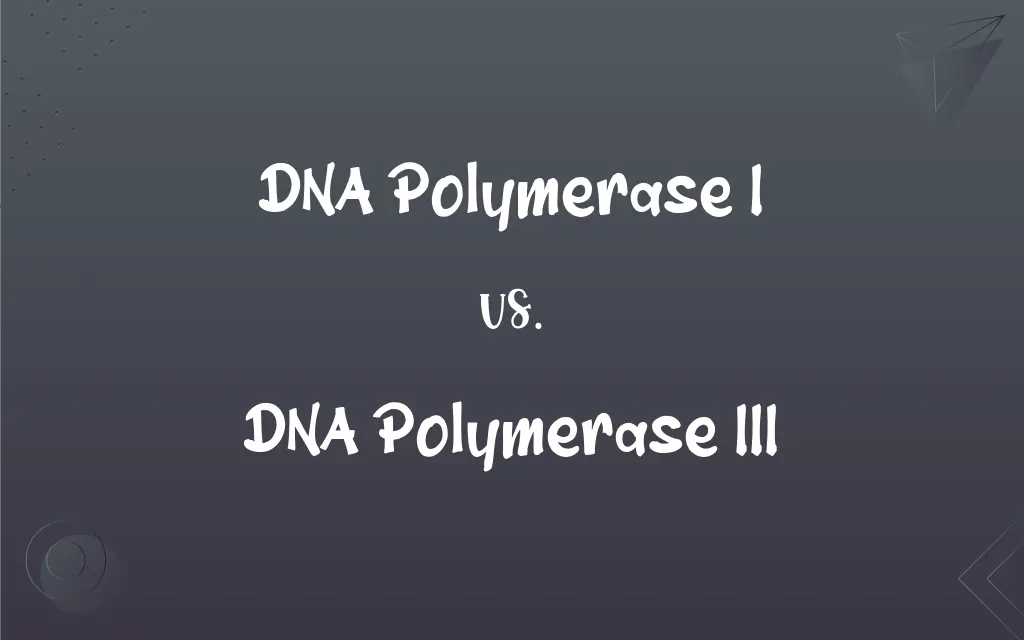DNA Polymerase I vs. DNA Polymerase III: What's the Difference?
Edited by Aimie Carlson || By Janet White || Published on February 10, 2024
DNA polymerase I is mainly involved in DNA repair and primer removal, while DNA polymerase III is the primary enzyme for DNA replication in bacteria.

Key Differences
DNA polymerase I, discovered by Arthur Kornberg, is primarily involved in DNA repair mechanisms in bacteria. In contrast, DNA polymerase III, also identified by Kornberg, serves as the chief enzyme for bacterial DNA replication, playing a critical role in copying the bacterial genome during cell division.
The function of DNA polymerase I is to remove RNA primers used during DNA replication and replace them with DNA. DNA polymerase III, on the other hand, is responsible for the bulk of DNA synthesis during replication, adding nucleotides to the growing DNA strand.
DNA polymerase I possesses exonuclease activity, enabling it to remove nucleotides and correct errors. DNA polymerase III, distinguished by its high processivity and speed, lacks this proofreading ability but is assisted by other enzymes for error correction.
In terms of structure, DNA polymerase I is a single polypeptide, making it simpler than DNA polymerase III, which is a complex holoenzyme composed of multiple subunits, each contributing to its replication function.
DNA polymerase I operates on a smaller scale, dealing with short stretches of DNA. Conversely, DNA polymerase III is designed for long, continuous DNA synthesis, making it essential for efficiently copying large bacterial genomes.
ADVERTISEMENT
Comparison Chart
Primary Function
DNA repair and primer removal
Main enzyme for DNA replication
Discovery
By Arthur Kornberg
Also discovered by Arthur Kornberg
Activity
Removal of RNA primers, DNA synthesis
Continuous, rapid DNA synthesis
Exonuclease Activity
Yes, for error correction
Lacks inherent proofreading ability
Structural Complexity
Single polypeptide
Complex holoenzyme with multiple subunits
ADVERTISEMENT
DNA Polymerase I and DNA Polymerase III Definitions
DNA Polymerase I
Essential for post-replication modifications in bacteria.
DNA polymerase I plays a vital role in modifying bacterial DNA post-replication.
DNA Polymerase III
Lacks inherent proofreading ability, relying on other enzymes.
While DNA polymerase III rapidly synthesizes DNA, other enzymes handle error correction.
DNA Polymerase I
Discovered by Arthur Kornberg, highlighting its historical significance.
The discovery of DNA polymerase I by Kornberg was a milestone in molecular biology.
DNA Polymerase III
A complex holoenzyme with multiple subunits.
The structural complexity of DNA polymerase III, with its multiple subunits, aids in effective replication.
DNA Polymerase I
A bacterial enzyme involved in DNA repair and RNA primer removal.
DNA polymerase I meticulously replaces RNA primers with DNA during replication.
DNA Polymerase III
Characterized by high processivity and rapid DNA synthesis.
The high processivity of DNA polymerase III enables efficient bacterial genome replication.
DNA Polymerase I
DNA polymerase I has 5'→3' exonuclease activity for error correction.
The exonuclease activity of DNA polymerase I ensures the accuracy of DNA repair.
DNA Polymerase III
Also discovered by Arthur Kornberg, emphasizing its discovery's importance.
Kornberg's discovery of DNA polymerase III was pivotal in understanding bacterial replication.
DNA Polymerase I
It is less complex than DNA polymerase III, comprising a single polypeptide.
DNA polymerase I's simpler structure contrasts with the complexity of DNA polymerase III.
DNA Polymerase III
The primary enzyme responsible for bacterial DNA replication.
DNA polymerase III is crucial for duplicating the bacterial genome during cell division.
FAQs
What is DNA polymerase I?
It's an enzyme in bacteria involved in DNA repair and RNA primer removal.
What is the primary role of DNA polymerase III?
It's the main enzyme for bacterial DNA replication.
Does DNA polymerase I have proofreading ability?
Yes, it has 5'→3' exonuclease activity for error correction.
Is DNA polymerase III responsible for primer removal?
No, that's the function of DNA polymerase I.
What is the structural complexity of DNA polymerase I?
It is a single polypeptide, less complex than DNA polymerase III.
Does DNA polymerase I play a role in replication?
Yes, but mainly in primer removal and repair, not bulk synthesis.
How does DNA polymerase III's lack of proofreading affect replication?
It relies on other enzymes for error correction.
Who discovered DNA polymerase I?
Arthur Kornberg discovered it.
How does DNA polymerase III function in replication?
It adds nucleotides to the growing DNA strand with high processivity.
Can DNA polymerase I synthesize DNA?
Yes, it can, primarily when replacing RNA primers.
How are these enzymes important in molecular biology?
They are key in understanding DNA replication and repair mechanisms.
Is DNA polymerase III a holoenzyme?
Yes, it's a complex holoenzyme with multiple subunits.
Are both enzymes discovered by the same scientist?
Yes, both were discovered by Arthur Kornberg.
Is DNA polymerase III involved in DNA repair?
Its primary role is replication, not repair.
What's the speed of DNA polymerase III's replication?
It replicates DNA rapidly and efficiently.
How does DNA polymerase III contribute to bacterial survival?
By efficiently replicating the bacterial genome for cell division.
What's the role of DNA polymerase III in primer synthesis?
It doesn't synthesize primers; that's the role of primase.
What makes DNA polymerase I unique in its function?
Its role in removing RNA primers and repairing DNA.
Can DNA polymerase I synthesize long DNA strands?
It mainly works on short stretches of DNA.
Are there similar enzymes in eukaryotes?
Eukaryotes have analogous enzymes, but with different specifics.
About Author
Written by
Janet WhiteJanet White has been an esteemed writer and blogger for Difference Wiki. Holding a Master's degree in Science and Medical Journalism from the prestigious Boston University, she has consistently demonstrated her expertise and passion for her field. When she's not immersed in her work, Janet relishes her time exercising, delving into a good book, and cherishing moments with friends and family.
Edited by
Aimie CarlsonAimie Carlson, holding a master's degree in English literature, is a fervent English language enthusiast. She lends her writing talents to Difference Wiki, a prominent website that specializes in comparisons, offering readers insightful analyses that both captivate and inform.































































